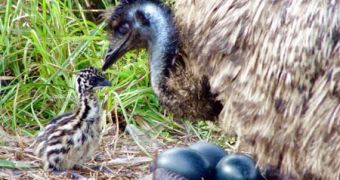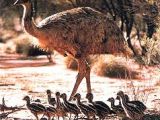Emu (Dromicaeus novaehollandiea) is represented on the emblem of Australia, being one of the Australians that cannot walk in "marche-arriere". This relative of the African ostrich can be 2 m (6.6 ft) tall (the second tallest living bird after the African ostrich) and weigh 35-50 kg (75-110 pounds), a third place amongst birds after the ostrich and cassowary.
This "Australian ostrich" has a shorter neck than in the case of the African species, and three toes, not two. The feathers are long, soft, thick and bushy. The head and neck skin, where uncovered by feathers, is bluish. Eyes are yellow, gray, brown or reddish.
Two dwarf emu species, living on islands, disappeared when the Europeans colonized Australia; only the large species survived, with three races: novaehollandiae in southeastern Australia, woodwardi in the north and rotschildi in southwest.
The name of the bird come from the Portuguese word "ema" ("ostrich"). Portuguese named the South American ostrich (the rhea or nandu) emu and the word was taken by English to name the bird they encountered in Australia. Emu was named "kalaya" by the Aborigines and it was hunted for meat. Emu were perceived as pest by many white farmers, who consequently hunted them.
Emu lives on flat plains near a water source, and after rains, it enters deeply into the desert. The bird drink once a day in the winter, and twice a day in the summer. At each watering, the bird takes about 70 water shots. The bird can stand temperatures over 40o C as its nose has a special structure that, by using water evaporation, decreases blood temperature. The plumage too is very effective in insulating, as skin temperature may be 20o C less than that at the surface of the feathers.
This bird is omnivorous, eating grass, flowers, fruits, seeds, insects and their larvae, and even tree bark when there's nothing else. In inhabited areas, they are known to swallow many non-comestible man-made items (usually shiny).
Emus are solitary, but during the breeding season they form pairs. The nests are located 2-3 m (1.2-1.8 mi) one from another. Still, during the foraging, emus can gather in small herds.
The top speed of an emu is 40 km (25 mi) per hour, and the bird can defend itself with powerful kicks against any predator. Moreover, the middle toe has a 15 cm (6 in) long claw! The male defends the female against foxes, dingo, bewildered cats or eagles.
Emu nests inside the scrubland close to a water source. The nest is made by the male from grass, leaves, twigs and tree bark on the ground under a tree, a bush or close to a grass tuft. The nest is 10 cm (4 in) thick and 1-2 m (3-7 ft) wide.
Mating period starts during the cool, rainy Australian winter, from May to June, when daylight hours shorten. If you travel into the Emus' territory during this period, you will be amazed to hear some very low waves of sounds. Literally, the air is filled with this noise.
To the surprise of the first biologists who studied the emu, the vibration-like sounds are produced by females through the air sacks from their chests! These sounds are called "drumming" or "booming". The deep rumbling sound, with its very low frequency, has properties similar to the infrasounds emitted by elephants for long distance communication, and that's why they travel far away many miles.
During the courtship, both genders start strutting and circling; ruffling out their feathers and cocking their heads in a shy posture. The male starts a mating dance with slow, snake-like back-and-forth movements of his head while circling the female. The male needs a lot of patient persuasion to get a conquest, otherwise the larger female can turn very aggressive.
Once formed, the pair may last about five months, mating every 1-2 days, and the female will lay a dark-green egg, up to 900 g (2 pounds, as big as 12 chicken eggs, with a 2 mm thick eggshell), every 3 to 4 days. As the female lays her eggs, the male would group them into a rough nest of bark, grass, sticks and leaves sheltered in a small hollow built by him.
When there are already 6 to 9 eggs on the nest (but the female will continue laying more), he starts nesting, ceasing to eat, drink or defecate for 56 days, living off the thick fat layer on his back. During this period, he will lose one third of his weight.
But don't get fooled by this touchy female image. Despite the initial pair-bond relationship, soon after the male starts brooding, the female will look for other partners. She uses her deep call to invite another male to begin building a new nest for her so that she can produce a second clutch. Or not.
Sometimes, as many as half of the offspring from the initial nest may be fathered by others (or sometimes by none of the partners, as some females can deposit their eggs in totally foreign nests).
In abundant rainy seasons, she will lay up to three separate clutches. Those low frequencies sounds will be heard by males from many miles away and will do the job of bringing them to these hot-blooded chicks.
Offspring can leave the nest 5-24 hours after hatching, but the male stays with them at the nest for about 4 days. He will take care of them until the young are 18 months old (when they reach sexual maturity). In the first 2-3 months of life, the chicks shelter under their father's wings during the night or in wet or cold days.
Emu are not very smart; the aborigines just hid in a bush, swishing leaves, breaking twigs or mimicking bird's call and the curious bird approached, being easily speared.
50 Australian farms deliver 50,000 emus annually (now, emu farms are also found in US). The birds are grown for the protein-rich meat and feathers (for pillow and doll fillings). The fine speckled skin is used for making bags, and the claws and eggshells for ornaments.
An adult bird delivers 8 liters of oil (under skin fat), used in the pharmaceutical industry for preparing some anti-inflammatory oily solutions and ointments.

 14 DAY TRIAL //
14 DAY TRIAL // 
